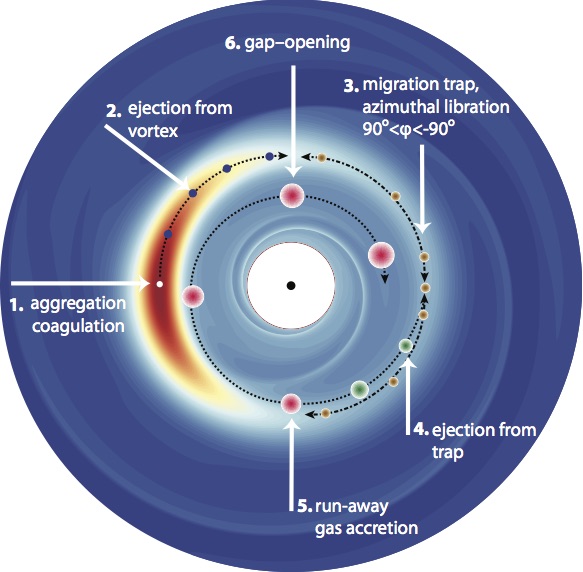Research Goals
Planet formation studies are still at an exponential exploratory phase. As of today, more than 2000 exoplanets have been discovered showing astonishing diversity. Observations reveal terrestrial rocky planets, gas giants with even 10 Jupiter masses orbiting in close vicinity, or at farther distances from their host star, which can be single stars or even binaries. One of the fundamental mission of the modern astronomy is to understand how these planetary systems formed and why their architectures are so different form that of the Solar System.
|
Formation of planets can be explained within the context of core-accretion theory. According to this theory, the dust particles coagulate and form planetesimals, which is followed by gravity-assisted collisions to form terrestrial planets and cores of giant planets. The growing giant planet core, orbiting in a gas-rich environment, can collect a massive gas envelope via runaway gas accretion, resulting in the formation of giant planets. Our research addresses several unsolved problems of current theory of planet formation by a novel concept, the planet formation in anticyclonic vortex developed at the outer edge of discs's accretionally inactive zone. The new scenario can solve the problems related to the formation of planetesimals, too fast planetary migration, and too slow formation of the cores of giant planets. We will address several aspects of our concept by means of 2D and 3D global hydrodynamical and N-body simulations. We will investigate the interactions between the gaseous and dusty material of disc as well as planetesimal-disc and planet-disc interactions. We aim at comparing the architectures of synthetic and observed exoplanetary systems. |
 Vortex-aided planet formation scenario in six steps 
Vortex-aided planet formation scenario in six steps |
Observational confirmations are necessary to verify our concept. Since sub-mm images can reveal the existence of vortices, our concept will be tested with the today's highest resolution interferometer ALMA. In our scenario giant planets can form rapidly in gas-rich discs and perturbs the gas orbits causing observable signatures in the near-IR molecular emission. To detect those planets, we will search for such signals in transitional discs with the todays's highest resolution near-IR spectrograph CRIRES+.
Fundamental Questions to Answer
In our research, we proposed a novel planet formation scenario based on the local accumulation of gas and dust inside a large-scale vortex at the outer boundary of the accretionary inactive region "dead zone" of the disc, where the effective viscosity changes significantly. Such a vortex can accelerate the planet formation and reduce the migration of planetary cores saving the newly formed planets from the deadly stellar engulfment.
The following questions will be answered by means of global hydrodynamical and N-body simulations that model the disc-dust-planet interactions in 2D and 3D geometries:
- What are the effects of the enhanced dust transport on the initial conditions for creating planetary embryos inside vortices?
- What are the formation rate of planetary embryos inside the vortices?
- How fast can terrestrial planets form and cores of giant planet inside vortices?
- How vortices affect the Type I migration history of terrestrial and giant planet cores?
- How fast can giant planets form inside vortices?
- How vortices affect the Type II migration history of giant planets?
- What kind of planetary architectures can be developed via vortex-aided planet formation?
- What is the difference between the orbital configurations given by vortex-aided planet formation and those of explored in exoplanetary systems?
Project Details
The research plan of our project entitled New directions in understanding planet formation: Vortex-aided planet formation can be downloaded here: OTKA-119993-ResearchPlan.pdf. Members of the research group are from Konkoly Observatory (3 PhD students and 5 PhD researchers) and Department of Astronomy at Eötvös Lóránd University (3 PhD researchers). The research project was funded by the National Research, Development and Innovation Office of Hungary in 2016. The total budget of this four year project is EUR 110 000.
Publications

